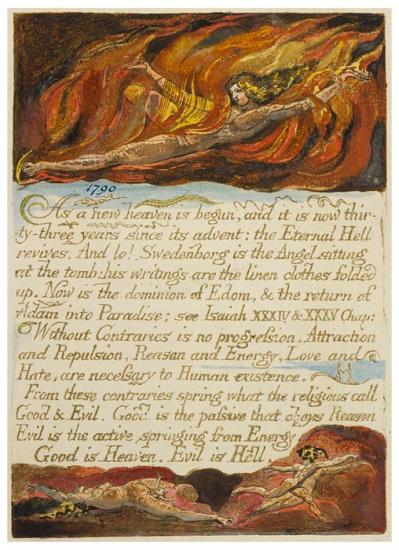
The Marriage of Heaven and Hell
[Lambeth, ca. 1794].
Relief and white line etching, with color printing and hand coloring
Copy F, printed ca. 1794
Gift of Mrs. Landon K. Thorne, 1973
Although the title page is undated, the twenty-seven plates of Marriage were probably created in 1790, as is indicated in ink on this plate of a 1794 printing. The date highlights Blake's claim that at age thirty-three he represented a "new heaven" of artistic creativity. His third illuminated book, Marriage was his first created in Hercules Buildings in Lambeth. This copy, which was once owned by Thomas Butts, Blake's great patron, was "color printed" by applying the pigments for the background directly to the shallow-etched printing plate.
The Morgan also owns Copy C, one of the four copies printed in 1790.
William Blake (1757–1827) occupies a unique place in the history of Western art. His creativity included both the visual and literary arts. In his lifetime he was best known as an engraver; now he is also recognized for his innovative poetry, printmaking, and painting. Blake's keen perception of the political and social climate found expression throughout his work. His strong sense of independence is evident in the complex mythology that he constructed in response to the age of revolution.
Blake was already recognized as an engraver at age twenty-five, when his first volume of poems appeared. At thirty-three, in The Marriage of Heaven and Hell, he audaciously claimed that his birth had marked the origin of a "new heaven" in which his own art would exemplify the creativity prefigured by Milton and Michelangelo. By that time, Blake, in one of his most productive periods, had already produced Songs of Innocence and was at work on a series of illuminated books. In 1818 he met John Linnell, a young painter and engraver, through whom a group of young artists became Blake's followers. Calling themselves the Ancients, they helped perpetuate Blake's influence for generations.
The Morgan's Blake collection—one of this country's most distinguished—began with purchases as early as 1899 by Pierpont Morgan. During the tenure of Charles Ryskamp, director from 1969 to 1986, major gifts almost doubled the size of its Blake holdings. In recent years Ryskamp's own gifts of engravings, letters, and related materials have significantly enriched its scholarly resources.
This online exhibition is presented in conjunction with the exhibition William Blake's World: "A New Heaven Is Begun" on view September 11, 2009, through January 3, 2010.
This exhibition is made possible through the generosity of Fay and Geoffrey Elliott.
